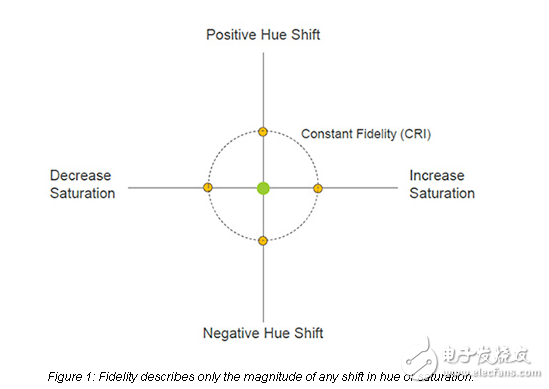
资料下载

×
Any Color, As Long As It’s White – Could TM-30 Be the Unambiguous Color-Quality Metric We Need?
消耗积分:0 |
格式:rar |
大小:0.40 MB |
2017-05-09
Any Color, As Long As It’s White – Could TM-30 Be the Unambiguous Color-Quality Metric We Need?
固态照明的到来使普通消费者在照明的鉴赏家。人们很快意识到,有更多的选择,作出正确的决定是至关重要的-无论是国内情绪照明,和平和生产性的办公照明,照明关键任务,如手术,或显示商品在其最好的。
一切都是如此简单,包括公认的指标灯性能。多年来,照明行业一直使用的颜色渲染指数(CRI)作为一个简单的表达的平均保真度与一组标准的颜色样本渲染。样本集可能包括多达14种颜色,包括中等色度的粉彩色调,饱和红,黄,绿,蓝的颜色,和标准化的肤色。

After determining the Correlated Color Temperature (CCT) of the light source to be tested, a reference source of the same CCT is calculated and the color samples are then illuminated by the test source and the reference source. The coordinates of the illuminated colors in the CIE Y-U-V color space are then determined, and the distance between the pairs of coordinates for each sample (Ei) is calculated and used to generate a set of results (Ri) that express the fidelity for each sample. The arithmetic mean of these values gives the CRI of the test source.
As a straightforward metric that is relatively easy to calculate and easy to understand by experts and consumers alike, CRI has been the favored industry yardstick for many years. It has been adequate for use with incandescent lighting, which has afforded few opportunities for manufacturers to artificially adjust the characteristics of ordinary white (non-colored) light sources. Now, however, the complex processes by which LEDs are made to generate white light gives manufacturers opportunities to offer a wider variety of choices. CRI is unable to describe the difference in color for any specific object, and hence cannot give an understanding of how one source will make objects look compared to another. Moreover, unscrupulous suppliers can take advantage of the simplicity of CRI to engineer a high score for inferior products. The lighting industry and end users need a more robust and less ambiguous metric to describe the color quality of white LEDs
声明:本文内容及配图由入驻作者撰写或者入驻合作网站授权转载。文章观点仅代表作者本人,不代表电子发烧友网立场。文章及其配图仅供工程师学习之用,如有内容侵权或者其他违规问题,请联系本站处理。 举报投诉
评论(0)
发评论
- 相关下载
- 相关文章






